Rehabilitated penguins
White flippered penguins, where can they be found?
The Penguins we have here at Pohatu near Akaroa are very special, they are called White-flippered penguins, a variant of Little penguin. They have a white leading edge and trailing edge on their flippers which they are named for and are slightly taller than their cousin the Little Blue penguin, which is found in other parts of New Zealand and Australia.
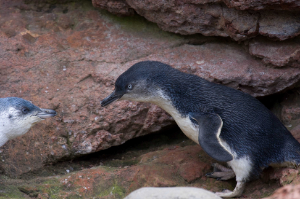 |
 |
White-flippered penguins are only found in the Canterbury region of New Zealand and are different in their colouration, and also behaviour, in comparison to other variants of Little penguins.
Over time they have adapted to Canterbury’s coastal waters, the glacial silt which comes down from the southern Alps in our rivers ends up in the ocean around Banks peninsula and makes our water a turquoise blue colour. Penguins over time adapted a lighter coloration to match these unique waters.
White-flippered penguins are a beautiful turquoise blue colour when they first fledge at about 7 to 8 weeks old, they have totally lost their baby fluff and have their new waterproof feathers and are ready to go to sea for the first time.
Young ones spend most of their time in or on the water they don’t necessarily need to come ashore. Predators like birds of prey flying over the water find it harder to see them due to their colouration.
Our penguins on average mostly dive to depths of 6 meters hunting small fish where the water is the turquoise blue colour.
Bigger penguin species like our Yellow eyed penguins can dive down 40 to 120 meters, it is very dark down there and likely to be a contributing factor for their black coats.
Underneath all penguin species are white and this camouflage is to stop predators like sharks or seals from seeing them easily as well. When you look up from down in the ocean you see mostly white colour against the sky and when you look down in the deep ocean it looks black.
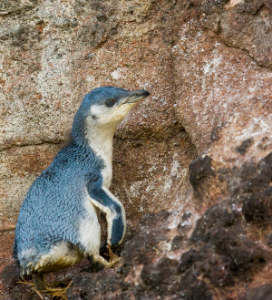 |
-780.jpg) |
When Little penguins are 2 to 3 years old, they think about starting a family. They have to find a nice place to live, naturally they like to live in a colony so they have neighbours they can walk home with after dark. Safety in numbers, and only coming ashore in the hours of darkness is how they have adapted to avoid predator birds.
They dig holes in the ground like a rabbit burrow, somewhere safe away from birds of prey or if they are feeling lazy, they steal burrows from rabbits, or other penguins, even their own parents burrows.
Little penguins seem to have a built-in memory of where they were raised and will always return to within a few meters of that area. Once they have found a good spot, they will always try to remain there for the rest of their life, unless they get kicked out by another penguin family.
Banks Peninsula is made up of old extinct volcanoes, all around us are beautiful harbours, bays and steep rolling hills. Little penguins here can walk up to 850 meters inland and 200-meters altitude from sea level. In the past before human arrival they nested under a thick canopy of forest and dug burrows under tree roots or rocks.
Male penguins attract a girlfriend by providing a nice place to live, burrows can take up to 3 years of digging in the hard pact clay found around Banks peninsula. Once dug/or stolen, he builds a nest inside the burrow, if he can impress her, she will give him a chance. These penguins are just like people, some will stay together for life, and some might get a divorce, it all depends how well they work as a team when raising their young.
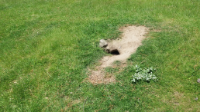 |
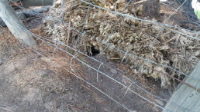 |
As White-flippered penguins get older and start raising a family their feathers change to a light blue grey colour which blends in with banks peninsulas coastal rocks extremely well. They usually come up on the same rocks every night to preen just before climbing the hills to get home. The rocks become covered in penguin poop over the breeding season, which also aids with camouflage, as their white underbelly makes them invisible from a distance. It becomes very hard to spot penguins on the rocks if they are not moving. If birds of prey happen to fly over, they freeze not moving or they jump straight back into the water where they can speed away from harm and join up with the penguin rafts on the water.
At sea, they like to raft up in the water bobbing around in a group (safety in numbers). Someone in the group can always alert the others about predators, they also like to take a little break just before they make their way up home to feed their chicks. They wait until it gets dark and for all signs of birds of prey to be gone before climbing up the hills to get home.
White-flippered penguins usually have 2 chicks and raise them until they are on average 7 to 8 weeks old , that's when the chicks are usually ready to fledge/take off to sea for the first time.
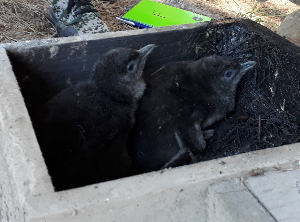 |
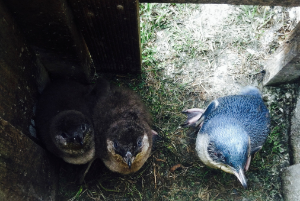 |
New Zealand was a land of birds, those penguins like other birds of New Zealand adapted to have only one clutch of 2 eggs per year, Little blue penguins have 2 clutches per year on average.
White-flippered penguins living in New Zealand were without land predators for a long time, so could afford to be less productive having chicks. Once safe and sound in the burrow the chicks were safe from harm. Little Blue penguins living in Australia had to worry about other things like snakes, lizards and land mammals which could take their eggs, so they double clutched every year raising 2 lots of chicks, hopefully mitigating these factors and facilitate species survival .
In the breeding season adult White-flippered penguins spend most of their day hunting small fish for their chicks and bringing the food back every night if they can. They carry it in their stomach and regurgitate up a fishy soupy mixture mixed with a natural protein for their chicks. Sounds gross but if all goes well two adult penguins can raise their two chicks to 8 weeks old and they will be the same size as mum and dad.
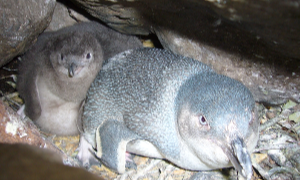 |
Once adults have raised the chicks and they have gone to sea they start to think about themselves for once, they also head off to sea and stay out there. Little penguins on average spend 80% of their life in or on the water, only coming ashore for the breeding season, to rest on occasion, and to molt.
Their feathers get very worn out during the breeding season and once a year they need to replace the old worn feathers and have beautiful new blue coat again.
They spend weeks and weeks out in the ocean trying to put on as much weight as possible. Their body tells them it’s time to molt, lose all the old feathers, so they come back home to their burrows and hunker down for almost 2 weeks without food and water, using up their fat reserves to get through. While molting they can’t go in the water as they get water logged with all the old feathers falling out and not being waterproof any longer, they don’t have as much insulation either.
They sit around waiting and pulling out old feathers, sometimes they molt together as a couple or sometimes alone.
Some smart penguins like to just molt on the rocks where they can hide in cracks in the day time or rely on their amazing camouflage and at night go down to the waters edge for a drink.
When molting has finished the adult penguins now have a beautiful new blue coat, ready for life at sea until the next breeding season.
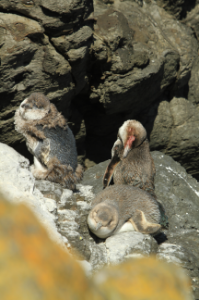 |
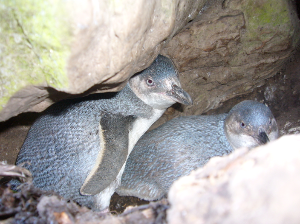 |
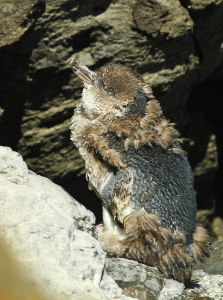 |
Banks peninsula’s White-flippered penguins start the breeding season with nest building in August. They have most of the chicks by October/ November, and chicks start to fledge during December/ January. Adults start to leave as well in December and January to fatten up for the molt. Mid-January to mid-February is molting time and then everyone takes off to sea for a long time. They return for a big penguin party most years by mid-April and come and go regularly in the winter months to rest in the burrows, or check it out making sure their home still theirs for the next breeding season.
For a long time they were considered a sub-species of the Little blue penguin, in recent years they are now called a variant, kind of like cousin.
The Pohatu penguin colony near Akaroa mostly consists of White-flippered penguins but over the years Little blue penguins have come into the colony and are now interbreeding.
The hybrid of the two is usually a darker blue typical of Little blues but having the white leading and trailing edge on the flippers. Very distinctive White-flippered penguins have a white patch in the middle of the flipper attach to the trailing edge.
One of our frequently monitored nesting boxes F34 has a mixed couple, which is rather interesting as they have been together for years now. She is a Little blue and he is a White-flippered penguin. She double clutches some years and on the second clutch of eggs he does not help her, he takes off to sea to begin his molt.
Often in this situation she is trying to incubate eggs on her own and luckily due to warm summer weather she has managed to hatch chicks, she tries to raise them on her own.
She returns every second day like she would do with a partner. Later on the male will come back to molt sitting next to his chicks which he unfortunately can’t feed. In this situation we do give a helping hand supplement feeding when she’s away, and if the male comes back to molt, we take the chicks into the rehab garden to build them up to a good weight so they are ready to go to sea.
There are a few more Little blues and White-flippered penguin couples but they don’t seem to double clutch like nesting box F34, possibly because F34 is a female Little blue and the other couples might be male Little blues with female White-flippered, it’s hard to tell.
|
White-flippered penguins are still considered to be an endangered species. Their strong holds are Motunau Island off the coast of Canterbury and Pohatu bay on Banks peninsula, both of which have the largest colonies. They are found spread out in smaller colonies all around Banks peninsula however, and are now growing in some areas which are part of the Wildside conservation project. Motunau Island has a colony of 2500 pairs and many other endangered species living there, from sea birds to native plants. The island is restricted to only researchers with a special Department of Conservation permit to enter, as the habitat is very sensitive with penguins’ burrows honey combing the whole tiny island. The island is also predator free due to intensive conservation work. Pohatu is a small south-eastern bay of Banks peninsula and is privately owned where the land owners started penguin conservation 40 years ago. The main goal being to keep the area predator free and provide nesting opportunities for a stable breeding colony. Later branching out into penguin rehabilitation, forest restoration and penguin tours under Pohatu penguins. Pohatu has 1,250 breeding pairs and is the largest White flippered penguin colony found on mainland New Zealand. Due to being on the mainland keeping the predators out is the hardest part of the work, but the Pohatu colony keeps growing, and the conservation effort has inspired the amazing Wildside project. People are also restricted here as the colony is nesting on private property. Tourism to see penguins is guided in small groups, keeping human impact on penguins minimal and also funding the Pohatu conservation project. |
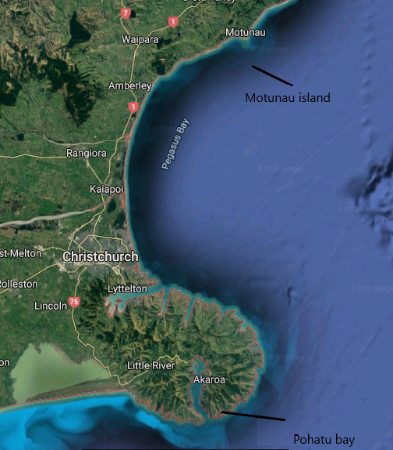 |
|
Ideally, we don’t want to handle our penguins at all. However, some of them need our help whether it be from an injury, illness or malnourishment. Pohatu Penguins steps in and gives these little birds a second chance at life! Most of our rehabilitated penguins are underweight or malnourished chicks. Typically, we find these chicks during our tours as we monitor the nesting sites. Why are the chicks malnourished/underweight?
What do you do in rehabilitation? This depends on the penguins needs and condition. Typically we will feed them 2-3 times a day depending on their weight and age. If they are old enough we will bring them for a swim in our “swim therapy pool”. Here, we introduce them to the water and determine if they are ready to be released. Injured or sick penguins will be sent to either a specialized penguin vet or dedicated specialists, Kristina and Thomas*, in Christchurch where they are assessed for future placement. Permanently injured penguins have the chance to live out their lives at the Antarctic Centre. *K&T Link: https://www.stuff.co.nz/environment/88518082/christchurch-couple-give-injured-rescue-penguins-the-full-pamper-treatment ParniaI spotted Parnia while kayaking; she was standing on the rocks looking extremely thin and weak. After getting back onto shore I quickly grabbed a bucket and went on to retrieve her – she gave little resistance to capture. Once I saw her up-close I realized that she had a deformed beak, probably why she had been so thin. (It’s very difficult for penguins to hunt efficiently with a crooked beak, most die.) I had never seen such a thin penguin and I expected her to die within the day, but still it was worth a shot to try and save her. Penguin band: P 41 087One year a starvation event happened right in the middle of the breeding season. When starvation occurs parents stop feeding their chicks to save themselves or only do so periodically. Chicks are then forced to leave (or fledge) the nest early in search of food. Unfortunately, chicks under 8 weeks old are not properly equipped to survive at sea and either starve or drown. In order to prevent early fledgings I fed the chicks while they remained in their burrows, hoping that the starvation event would end soon. Slowly but surely the parents started to return consistently feeding their youngsters and relieving me of my duties! Two years later P41 087 (we used to band our penguins) turned up in one of my breeding boxes. He was one of the largest, most beautiful penguins I had ever seen. P41 087 was evidence that my feedings, two years ago, had been a success. It warmed my heart to know that I helped save this little penguin and build him up for a healthy, successful life in the wild. He was my pride and joy. RoxyRoxy was handed in by the Fox II, a tourist sailing boat in Akaroa. She was extremely thin with a severe injury to her eye. Roxy looked like a recently fledged chick that seemed to have been hit by a boat. Her condition was very grim and I had my doubts about her survival.
However, to my delighted surprise she survived the first 24-hours, then the next and the next, and by day 3 she was on the road to recovery! Her eye injury, however, would be permanent and she would never be able to see from it again. Although, she was doing well in rehabilitation we knew that she wouldn’t stand a chance in the wild, thankfully, Roxy was also sent to the Antarctic Centre where she’ll live out a long and luxurious life! Shark baitThis is an all time favorite story that demonstrates incredible intelligence – intelligence you would never expect from a penguin. One night, while running an Evening Penguin Tour, we found a horribly injured penguin beside the track. I immediately took him into care and the next morning rushed him to Christchurch for an emergency veterinary assessment.. He had several shallow, flesh wounds and a lacerated leg. We suspected the culprit had been a shark. The vet stitched him up and I took him home to recover.. He spent a few weeks with us recovering and eating lots of fish – something he was quite happy to do through his moult*! Once his moult was complete we returned him to the sea and he happily shot off like a rocket! One year later, while running a tour, in the same spot on the tarck out in the open, we found a penguin near the track and out in the open we found a penguin that did move away from us as he should. He also did not attempt to bit and was very relaxed when I picked him up to examine him to find an explanation for this strange behaviour. He was in very good condition, but lame in one leg as Shark bait was when we released him. He proved beyond doubt who we was when I tried to feed him. He snapped and gulp the fish down gleefully and then looked for more, greedy as ever. As he was looking forward to another free easy loading molt we decided to indulged him and sent him on his way, fat and sleek once his feathers were grown in. Once again he shot off, instantly a wild penguin, but we did wonder, would he be back next year for another easy moult*? *Little Penguins moult – loose their old feathers and grow new ones – for two weeks every year. During the moult they cannot hunt and thus starve until it is complete. Yappy WiggleThis was the funniest penguin I’ve ever cared for! One day, while monitoring nesting sites I came across a burrow with one healthy chick and one very small runt. If one chick gets too far behind they simply die and the fouled nest can cause the healthy chick to become sick and die. The best option was to take the runty chick out, but then what to do with it? I decided I would simply throw it in the bushes. It’s very difficult to raise chicks that are less than 2 weeks old, especially if they are runts, but I thought I’d give it a go. Trying to feed such a young chick was not easy, but the little guy responded well and started to put on weight. Soon enough he turned into a healthy, respectable penguin. He became far too tame, however, and ran around like a puppy dog, wiggling his tail and begging for food with sharp, yapping noises. When it came time for him to leave he wasn’t exactly keen. On the first release he returned the next day yapping his way up the drive, begging for more fish. He had obviously not found any for himself. I allowed him to stay for a few days until I figured that we better try again; so, for a second time we released him back into the wild. He returned the very next day for more fish. I fed him once more and came up with a new idea, we’ll release him by kayak! So, in our third release, we took him by kayak to the entrance of Flea Bay and let him go. This seemed to be successful until the fifth day when we saw him hobbling towards the house. This time he was much weaker, thinner and a bit injured. I assumed he had hurt himself along the rocks and barnacles while exiting the sea. After our third try, we realized that Mr. Yappy Wiggle had imprinted on us and would not succeed in the wild. He now happily resides in the Antarctic Centre yapping and wiggling all over the place! Our Christmas Eve SagaBefore you read this you must understand: Yellow Eyed Penguins are the rarest penguin in the world and are extremely endangered. Every single one is precious. One Christmas Eve during a penguin tour we saw one of our Yellow Eyed Penguins drag itself ashore, obviously injured and bleeding. We caught the Yellow Eyed to gauge its injuries in which its feet were badly cut. It looked as though it kicked itself free from the jaws of life and escaped a near death shark attack. It needed stitching as soon as possible if it was to survive, but what vet would be open on Christmas Eve or Christmas Day? Talk about bad timing. I rang our closest vet in Little River and to my surprise he said to bring it straight over. This was 10.00pm on Christmas Eve. We arrived in Little River at 11.30pm, but the vet was nowhere to be seen. We sat there waiting and silently panicking over this precious penguin’s life. Until suddenly a vehicle pulls up with the vet and vet’s family! In order to successfully and painlessly stitch the penguin he needed to be put under. However, this can be dangerous if the penguin has a full stomach – something we weren’t sure about. We simply had to hope for the best and move forward with the procedure. The penguin did not fair well with the gas, he kept drifting in and out of conscious. Then, suddenly he started to heave and projectile vomit fish across the table, the floor and even the walls! Now, you can imagine our surprise, you can also imagine that it was quite unexpected and unfortunately we did not have time to react. So, like the table, the floor and the walls, we too were covered in fish vomit. Merry Christmas indeed! Thankfully after loosing its stomach contents our Yellow Eyed Penguin drifted into sleep and the vet was able to finish the job. With stitched and bandaged feet we placed our groggy penguin back into our vehicle. As we had to get the penguin home our vet and his family had to clean up the fish vomit – lucky them! We bid farewell and wished our Christmas heros a very Merry Christmas. After Christmas I sent the penguin to Christchurch to my wonderful friends and penguin rehab specialists, Christina and Thomas. Once it healed properly we released our Christmas penguin back into the wild. |
 Feeding chicks Feeding chicks Rehabilitated penguins in our garden going for a walk  Swim! (allow the penguins to oil up their feathers)  Releasing an adult.  Two chicks ready to go! (White flippered and Little Blue)  Trying to release Yappy Wiggle.  Still trying to release Yappy Wiggle...  Yellow Eyed Penguin with stitched foot.    |
|
These are just a few of the more memorable birds we have had in care. We rehabilitate many penguins, mostly Little Penguins, sometimes Yellow Eyed and occasionally a Crested Penguin. Most are sent off to sea successfully! If you too wish to help visit our Adopt a penguin page. |
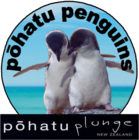

Comments